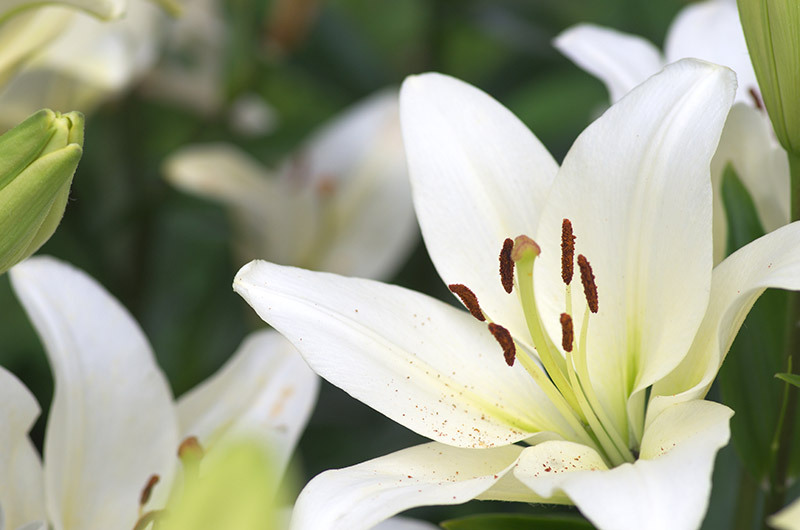Guarding the Beauty of Your Hydrangeas
Posted on 13/08/2025
Guarding the Beauty of Your Hydrangeas: Comprehensive Care and Protection Tips
Hydrangeas are renowned for their lush blooms and vibrant hues, making them a favorite among gardeners. Protecting hydrangeas is essential to maintain their beauty and ensure a spectacular display year after year. From their verdant summer blossoms to stunning fall foliage, these ornamental shrubs can be focal points in any landscape--if properly cared for. This article delves deep into guarding the beauty of your hydrangeas, offering expert guidance on plant health, pest control, environmental protection, and more.

Understanding Hydrangea Varieties & Their Needs
Before exploring protection strategies, it's vital to recognize the types of hydrangeas in your garden. The main varieties include:
- Hydrangea macrophylla (Bigleaf Hydrangea): Famous for blue, pink, or purple mophead or lacecap flowers.
- Hydrangea paniculata (Panicle Hydrangea): Known for cone-shaped white blooms that blush pink with age.
- Hydrangea quercifolia (Oakleaf Hydrangea): Boasts oak-shaped leaves and elongated white flowers.
- Hydrangea arborescens (Smooth Hydrangea): Includes the beloved 'Annabelle' with snowball blooms.
- Hydrangea serrata (Mountain Hydrangea): Hardy, compact, and ideal for colder regions.
Each variety may have specific needs, but the strategies for guarding hydrangeas overlap. Understanding your plant's variety helps tailor hydrangea care and protection for optimal results.
Best Practices for Guarding the Beauty of Hydrangeas
Choosing the Right Location
Site selection is the foundation of healthy, beautiful hydrangeas. Always choose an area with:
- Morning sun and afternoon shade for large-leaved varieties to prevent leaf scorch.
- Well-drained, fertile soil rich in organic matter.
- Protection from strong winds, which can break brittle stems and damage blossoms.
- Sufficient space to allow air circulation, reducing risks of mildew and rot.
Soil & Water Management
Guarding hydrangea beauty starts in the soil. Hydrangeas appreciate:
- Consistent moisture: but dislike soggy conditions. Water deeply when the top inch of soil is dry.
- Mulching: Apply 2-3 inches of organic mulch to keep roots cool, conserve moisture, and prevent weeds.
- pH Adjustment: Blue hydrangeas require acidic soils, while pink blooms need alkaline soils. Amend accordingly!
Proper Pruning Techniques
Pruning keeps hydrangeas tidy, encourages robust growth, and protects their delicate beauty:
- Remove dead or sick branches at any time of year.
- For bigleaf and mountain types, prune immediately after blooming to preserve next year's buds.
- Panicle and smooth hydrangeas should be pruned in late winter or early spring for bigger blooms.
- Don't over-prune--excessive cutting damages bloom production!
Feeding for Vigorous Growth
A balanced diet is key to preserving hydrangea beauty:
- Use a slow-release fertilizer in early spring and mid-summer.
- Avoid high-nitrogen fertilizers that cause leafy growth at the expense of flowers.
- Test your soil to address nutrient deficiencies.
Winter Protection Strategies
Guarding hydrangeas through winter is crucial, especially for bigleaf and mountain varieties:
- Apply a thick mulch layer in late fall to insulate roots.
- Wrap vulnerable stems with burlap or frost cloth in regions with freezing temperatures.
- Do not prune late in the season--buds need protection to bloom in spring!
Pest and Disease Management: Shielding Hydrangea Health
Common Pests Affecting Hydrangeas
Even the most stunning hydrangea can fall victim to pests. Vigilant hydrangea protection involves regular checks for:
- Aphids: Small insects that cluster on new shoots, causing distortion and sticky residue.
- Spider mites: Look for stippled leaves and fine webbing in dry weather.
- Scale insects: These sap-suckers resemble small, brown bumps on stems.
- Slug and snail damage: Notice holes in leaves or shiny trails.
How to Guard Against Hydrangea Pests:
- Hose off pests like aphids with a strong water spray.
- Encourage beneficial insects--ladybugs and lacewings love aphids!
- Handpick slugs and snails or use pet-safe traps.
- Apply insecticidal soap or neem oil for severe infestations.
Hydrangea Disease Prevention
Diseases can quickly mar your gorgeous hydrangea blooms if left unchecked. To guard against hydrangea disease:
- Water at the base to avoid wetting leaves--damp foliage encourages fungus.
- Remove any infected leaves or stems promptly.
- Choose disease-resistant hydrangea varieties for added peace of mind.
- Rotate hydrangea planting locations if fungal problems persist.
Common Hydrangea Diseases
- Powdery mildew: Appears as white powder on leaves, common in high humidity.
- Leaf spot: Brown or purple spots may appear on lower leaves after rain or overhead watering.
- Root rot: Often fatal, this is caused by poor drainage and overwatering.
Healthy, well-tended hydrangeas are far less likely to succumb to pest or disease problems. Regular monitoring is your best defense!
Environmental Protection: Battling Harsh Elements
Heat and Sun Stress
Hydrangeas often wilt during summer heat waves. Guarding your hydrangeas from sun damage involves:
- Planting in dappled shade or providing temporary shade with garden fabric.
- Watering in the cool morning hours to keep soil evenly moist.
- Avoiding reflected heat from walls or pavement wherever possible.
Protecting from Wind and Storms
Strong winds can severely damage hydrangea branches and flowers. Ensure that plants are supported and protected:
- Stake new or top-heavy plants to prevent stem breakage.
- Situate hydrangeas near fences or tall shrubs for natural windbreaks.
- Remove damaged flowers and leaves after storms to prevent rot.
Enhancing and Prolonging Hydrangea Blooms
Deadheading and Flower Care
Regularly removing spent blooms--or deadheading--encourages new growth and a tidier appearance:
- Cut flower heads just above the first set of large, healthy leaves.
- For varieties that bloom on old wood, stop deadheading in late summer to avoid removing next year's buds.
Soil Amendments for Colorful Hydrangeas
Did you know soil chemistry can change the color of some hydrangea blooms? For bigleaf types:
- Blue flowers: Maintain acidic soil with aluminum sulfate or coffee grounds.
- Pink flowers: Add garden lime to increase alkalinity.
*Always test your soil before adding amendments to avoid harming your plants.*
Avoiding Common Hydrangea Care Mistakes
Even experienced gardeners make mistakes that jeopardize hydrangea health and splendor. Be sure to avoid:
- Overwatering or insufficient drainage, leading to root rot
- Over-fertilization, which promotes more leaves than blooms
- Pruning at the wrong time, especially on hydrangeas that bloom on old wood
- Ignoring pest infestations or signs of disease until too late
- Failing to mulch, exposing roots to temperature extremes

Natural and Safe Solutions for Guarding Hydrangeas
Organic Pest and Disease Control
Many gardeners prefer organic methods to protect hydrangeas and the surrounding ecosystem. Some options include:
- Homemade sprays, such as diluted neem oil or insecticidal soap
- Encouraging birds and beneficial insects to patrol your garden for pests
- Companion planting with marigolds or garlic to repel unwanted insects
- Regularly removing debris and providing good air circulation
Safe Mulching and Soil Health
Use natural mulches such as shredded leaves, pine needles, or bark chips, which:
- Improve soil quality as they decompose
- Suppress weeds without chemical intervention
- Help maintain soil moisture and moderates temperature swings
Guarding the Beauty of Your Hydrangeas: Final Thoughts
Hydrangeas enliven your garden with their lush, captivating blooms--making them well worth the effort to protect. By following these comprehensive tips on guarding the beauty of your hydrangeas, you'll ensure robust health, magnificent blooms, and enduring hydrangea charm. Prioritize good site selection, soil health, appropriate watering, and vigilance against pests and diseases. With a little extra attention, your hydrangeas will dazzle for many seasons to come.
Frequently Asked Questions about Hydrangea Protection
- Q: Can I grow hydrangeas in containers?
A: Absolutely! Container hydrangeas require more frequent watering and high-quality, well-draining soil. They can be moved to protect from harsh weather. - Q: How can I revive a wilted hydrangea?
A: Deeply water the soil and provide afternoon shade. If roots are dry, a slow soak often revives droopy foliage within a few hours. - Q: What's the best mulch for hydrangeas?
A: Organic mulches such as bark, pine needles, shredded leaves, or compost are ideal for guarding hydrangea roots against temperature extremes.
By following these expert tips, you'll be well on your way to preserving the stunning beauty of your hydrangeas--the pride of any garden!
Latest Posts
Master the Art of Keeping Poinsettias Fresh and Blooming
Crafting Memorable Birthdays with These Flower Choices
Guarding the Beauty of Your Hydrangeas
What Does Your Birth Flower Symbolize About Your Unique Self
Explore 10 Incredible Low Maintenance Office Plants for Fresh Air





